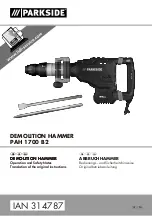
17
Starting, Stopping and Controlling Speed
For operation when using the Dust Extractor, refer
to your Dust Extractor manual.
1. To
start
the tool, grasp the handle firmly and pull
the trigger.
2. To
vary
the speed, increase or decrease the
pressure on the trigger. The further the trigger
is pulled, the greater the speed.
3. To
stop
the tool, release the trigger. Make sure
the tool comes to a complete stop before laying
the tool down.
Operating
Position the tool, grasp the handles firmly and pull
the trigger. Always hold the tool securely using both
handles to maintain control. This tool has been
designed to achieve top performance with only
moderate pressure. Let the tool do the work.
If the speed begins to drop off when drilling large
or deep holes, pull the bit partially out of the hole
while the tool is running to help clear dust. Do not
use water to settle the dust since it will clog the bit
flutes and tend to make the bit bind in the hole. If
the bit should bind, a built-in, non-adjustable slip
clutch prevents the bit from turning. If this occurs,
stop the tool, free the bit and begin again.
oPERATIoN
wARNINg
To reduce the risk of injury,
keep hands away from the bit and all moving
parts. Always wear safety goggles or glasses
with side shields.
Selecting Action
MILWAUKEE
Rotary Hammers have three settings:
rotation only, rotary hammer, and hammer only.
Always allow the motor to come to a complete
stop before changing the mode selection to avoid
damage to the tool.
1. For rotation only, rotate the
mode selector so the arrow
on the lever points to the
twist drill symbol.
2. For rotary hammering,
rotate the mode selector
so the arrow points to the
hammer and twist drill
symbol.
3. For hammering only, rotate the mode selector
so the arrow points to the hammer symbol.
4. To freely rotate the bit to the desired angle for
hammering only, rotate the mode selector to the
symbol. Then, follow step 3.
NOTE:
To engage the hammering mechanism,
maintain pressure on the bit. When pressure on
the bit is released, the hammering action will stop.
Using the Control Switch
The control switch may be set to three positions:
forward, reverse and lock. Always allow the motor
to come to a complete stop before using the control
switch to avoid damage to the tool.
For
forward
(clockwise) rotation, push in the control
switch from the right side of the tool. Check the
direction of rotation before use.
For
reverse
(counterclockwise) rotation, push in the
control switch from the left side of the tool. Check
direction of rotation before use.
To
lock
the trigger, push the control switch to the
center position. The trigger will not work while the
control switch is in the center locked position. Always
lock the trigger or remove the battery pack before
performing maintenance, changing accessories,
storing the tool and any time the tool is not in use.
wARNINg
Always remove battery
pack before changing or removing acces
-
sories. Only use accessories specifically
recommended for this tool. Others may be
hazardous.
wARNINg
To reduce the risk of injury,
always use a side handle when using this tool.
Always brace or hold securely.
wARNINg
Applying greater pressure
does not increase the tool's effectiveness. If the
applied working pressure is too high, the shock
absorber will be pushed together making the
vibrations to the handle noticeably stronger.
Operator Force
The Anti-Vibration System provides the operator
with comfort without sacrificing power or perfor
-
mance.
Ideal operator force compresses the bellows slightly
and allows the tool to work aggressively while the
handle remains steady.
Excessive force compresses the bellows signifi
-
cantly and reduces vibration dampening. Users will
be able to feel the difference and should adjust the
force to the handle accordingly.
Too Little Correct Too much
force force force


























